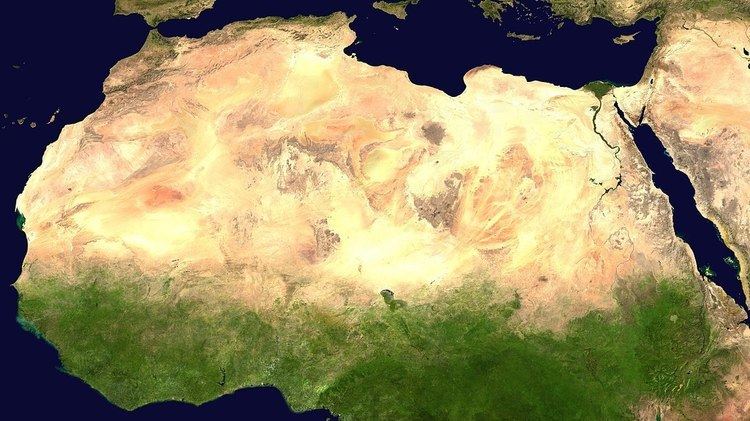 | ||
The Great Green Wall, or Great Green Wall of the Sahara and the Sahel Initiative (French: Grande Muraille Verte pour le Sahara et le Sahel), is Africa's flagship initiative to combat the effects of climate change and desertification. Led by the African Union, the initiative aims to transform the lives of millions of people by creating a great mosaic of green and productive landscapes across North Africa, the Sahel and the Horn.
Contents
From the initial idea of a line of trees from east to west through the African desert, the vision of a Great Green Wall has evolved into that of a mosaic of interventions addressing the challenges facing the people in the Sahel and the Sahara.[1] As a programming tool for rural development, the overall goal of this sub-regional partnership is to strengthen the resilience of the region's people and natural systems with sound ecosystem management, the protection of rural heritage, and the improvement of the living conditions of the local population.
Contributing to improved local incomes, the Great Green Wall of the Sahara and the Sahel Initiative (GGWSSI) will be a global answer to the combined effect of natural resources degradation and drought in rural areas.[2] The Initiative is a partnership that supports the effort of local communities in the sustainable management and use of forests, rangelands and other natural resources in drylands. It also seeks to contribute to climate change mitigation and adaptation, as well as improve food security in the Sahel and the Sahara.[3]
History
During an expedition to the Sahara in 1952 Richard St. Barbe Baker proposed a ‘Green front’ to act as a front-line of trees 30 miles deep to contain the desert. The idea then re-emerged in 2002, at the special summit in N'Djamena (Chad) on the occasion of the World Day to Combat Desertification and Drought. It was approved by the Conference of Leaders and Heads of States members of the Community of Sahel-Saharan States during their seventh ordinary session held in Ouagadougou (Burkina Faso) in June 1 and 2, 2005.
Since 2005, the Great Green Wall concept has developed considerably. Lessons learned from the Algerian Green Dam or the Green Wall of China led to understand the need of an integrated multi-sectorial approach for sustainable results. From a tree planting initiative, the Great Green Wall for the Sahara and the Sahel has evolved to a development programming tool. In 2007, during the eight ordinary session of the Conference of Heads of State and Governments held on January 29 and 30, 2007 in Addis-Ababa (Ethiopia), African Heads of State and Government endorsed the Great Green Wall for the Sahara and the Sahel Initiative with the objective of tackling the detrimental social, economic and environmental impacts of land degradation and desertification in the region.
Together, eleven Sahelo-Saharan states (Burkina Faso, Djibouti, Eritrea, Ethiopia, Mali, Mauritania, Niger, Nigeria, Senegal, Sudan and Chad) created the Panafrican Agency of the Great Green Wall (PAGGW).
The first step towards the Great Green Wall was set with the development of a Harmonized regional strategy for implementation of the Great Green Wall Initiative of the Sahara and the Sahel that was adopted in September 2012 by the African Ministerial Conference on Environment (AMCEN). According to AMCEN, the Great Green Wall is a flagship program that contribute to the goal of the United Nations Conference on Sustainable Development, or RIO+20, of "a land degradation neutral world".
In 2014 the EU and FAO, in collaboration with African and other regional partners launched the Action Against Desertification program to build on the GGWSSI.
The Drylands Monitoring Week (January 2015) aimed to assess the state of drylands measurement and to initiate collaboration toward large-scale, comprehensive monitoring.
Progress has been made on several fronts, including planning (including choices of vegetation and work with local populations in several countries) and plantings and land restoration (including in Ethiopia, Senegal, Nigeria, and Sudan).
Partners
The Great Green Wall for the Sahara and Sahel Initiative is an African Union program bringing together more than 20 countries from the Sahelo-Saharan region including Algeria, Burkina Faso, Benin, Chad, Cape Verde, Djibouti, Egypt, Ethiopia, Libya, Mali, Mauritania, Niger, Nigeria, Senegal, Somalia, Sudan, the Gambia and Tunisia.
The Initiative is backed by many regional and international organizations, including:
Major principles
The Great Green Wall of the Sahara and the Sahel concept has been defined in the continuity of discussions by the African Union Commission (AUC) and the CEN-SAD Secretariat. The Initiative is considered as a set of integrated actions related to issues “affecting people livelihoods in Sahel and Sahara”. The GGWSSI is not only a reforestation initiative, it is a programming tool for rural development.
The geographical scope of the Great Green Wall is defined as the Saharan strip, north and south borders, including Saharan oases and enclaves, such as Cape Verde.
The GGWSSI strengthens existing mechanisms (such as Comprehensive African Agricultural Development Program, Environmental Program (CAADP) of NEPAD, regional, sub-regional, and national action programs to combat desertification) to improve their efficiency in the Sahel-Saharan regions through synergy and coordination activities.
In order to ensure the success of this Initiative, the Regional Harmonised Strategy points out the importance of partnerships between stakeholders (at national, sub-regional and regional scales), integration of the Initiative in existing national regional and local programs, sharing and capitalization of lessons learned (especially through South-South cooperation and technology transfer), local participation and ownership of actions, developing a more integrated and global planning.
Implementation
Ecosia reports having planted over 3 million (3,746,777 as of 8 March 2016) trees, mostly in Burkina Faso, as part of the project. Although no other source for this can be found.
